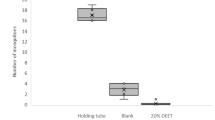Abstract
The residue left on glass surfaces by human hands was found to be attractive to femaleAedes aegypti (L.) andAnopheles quadrimaculatus Say mosquitoes. The material lost half of its activity in 1 hr. A solvent wash technique was developed to recover and concentrate the residuum from handled glass beads. The residuum could be recovered effectively with absolute ethanol and less effectively with several other solvents. More mosquitoes were attracted to heated than to unheated residuum, an indication of its volatility. Also, attraction of the residuum decreased with decreasing concentration or dose. Concentrated residuum collections, stored under refrigeration and tested for longevity, showed no appreciable loss of attractiveness up to 60 days of storage.
Similar content being viewed by others
References
Acree, F., Jr., Turner, R.B., Gouck, H.K., Beroza, M., andSmith, N. 1968.l-Lactic acid: A mosquito attractant isolated from humans.Science 161:1346–1347.
Bar-Zeev, M., Maibach, H.I., andKhan, A.A. 1977. Studies on the attraction ofAedes aegypti (Diptera: Culicidae) to man.J. Med. Entomol. 14:113–120.
Price, G.D., andCarlson, D.A. 1981. Controlled-rate evaporator for thousand-fold concentration.Anal. Chem. 53:554–555.
Price, G.D., Smith, N., andCarlson, D.A. 1979. The attraction of female mosquitoes (Anopheles quadrimaculatus Say) to stored human emanations in conjunction with adjusted levels of relative humidity, temperature, and carbon dioxide.J. Chem. Ecol. 5:383–395.
Schreck, C.E., Gouck, H.K., andSmith, N. 1967. An improved olfactometer for use in studying mosquito attractants and repellents.J. Econ. Entomol. 60:1188–1190.
Smith, C.N., Smith, N., Gouck, H.K., Weidhaas, D.E., Gilbert, I.H., Mayer, M.S., Smittle, B.J., andHofbauer, A. 1970.l-Lactic acid as a factor in the attraction ofAedes aegypti (Diptera: Culicidae) to human hosts.Ann. Entomol. Soc. Am. 65:607–612.
Author information
Authors and Affiliations
Additional information
Diptera: Culicidae.
This research was supported partly by the Medical Research and Development Command, Office of the Surgeon General, U.S. Army. Mention of a commercial or proprietary product does not constitute an endorsement by the USDA.
Rights and permissions
About this article
Cite this article
Schreck, C.E., Smith, N., Carlson, D.A. et al. A material isolated from human hands that attracts female mosquitoes. J Chem Ecol 8, 429–438 (1982). https://doi.org/10.1007/BF00987791
Received:
Revised:
Issue Date:
DOI: https://doi.org/10.1007/BF00987791




